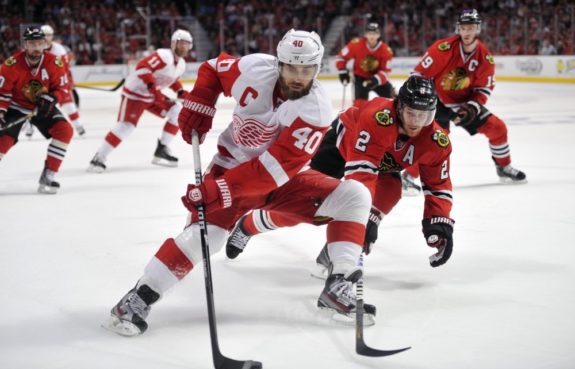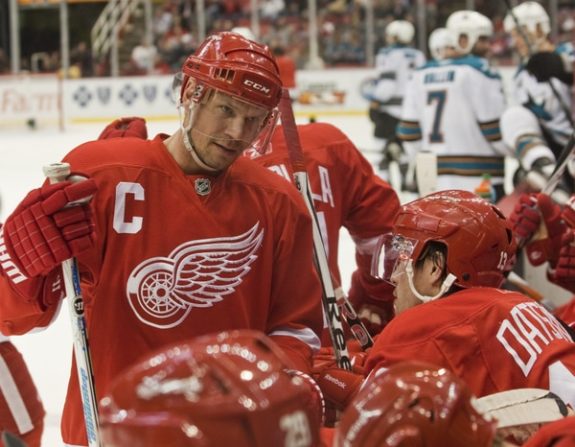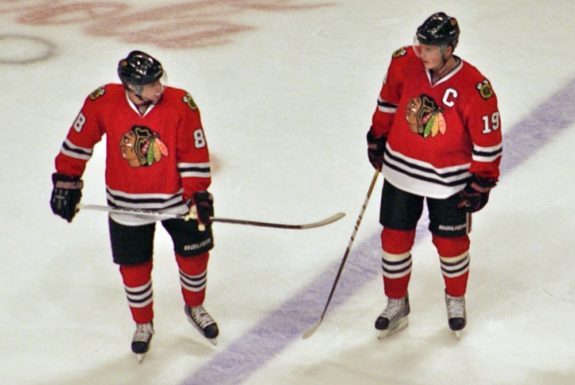We’ve all heard the rip-roaring, thunderous crowds at the United Center, in unison, chant “Detroit sucks!” But while these chants occur, many Blackhawks fans can only sarcastically shake their heads, as if to say “yeah, right.” It really doesn’t matter where the Red Wings are in the standings — Blackhawks fans love to take jabs at their older brother.
And that’s what a rivalry is — vitriolic reactions and feelings generated for and directed towards another team, usually of close proximity. But a positive case can be made for the Red Wings when assessing the rivalry between the two teams.

When the Blackhawks won their third Stanley Cup in a span of six seasons, their historic run in the salary-cap era solidified the “modern dynasty” label. The Blackhawks became the measuring stick for the rest of the NHL. Rosters were constructed and trades were completed to ultimately compete against Chicago for the Stanley Cup.
But before the Blackhawks became the measuring stick, it was the Red Wings. Year in and year out, the Red Wings were expected to advance deep in the playoffs. And why not? Looking at their impressive rosters for much of the early, mid and late-2000s, it makes sense.
While it might be bold to state, it probably is true and, thus, should be noted: the Blackhawks might not have won three Stanley Cups in six years if it wasn’t for the Red Wings.
Red Wings Recent Success
Over the years, the Red Wings have had some of the best and most impactful players on their rosters. Some of the best included many of the most famous names in hockey, such as Steve Yzerman, Nicklas Lidstrom, Dominik Hasek, Pavel Datsyuk, Henrik Zetterberg and countless more. The Red Wings roster, for many years, was exceptional.
But things weren’t always peachy for Detroit. Before winning the Stanley Cup in 1996-97 by defeating the Philadelphia Flyers, the Red Wings had failed to capture hockey’s holy grail for 42 years. An unfathomable 42-year drought for a team that many of us, at one point or another, have grown jealous of over the years.

The 1996-97 Stanley Cup championship for the Red Wings was just the beginning for a city that had been deprived of hockey’s ultimate prize for decades. One year later, the city of Detroit was rewarded once more for their patience as the Red Wings successfully repeated as Stanley Cup champs by defeating the Washington Capitals in four games. Next, they would win the Stanley Cup in 2001-02 by defeating the Carolina Hurricanes in a five-game series.
It would be six more years until the Red Wings would win the Stanley Cup again, and this time they would have to battle Sidney Crosby’s Penguins. The deep, star-studded lineup of the Wings prevailed once more in six games as they defeated the Penguins in 2007-08.
The Red Wings, undoubtedly, were the gold standard in the NHL at that time. They had set the bar astronomically high, and any team that wanted to come close, match or surpass their success would have quite the challenge ahead of them. Turns out, that team was the Blackhawks, and their first couple of steps towards emulating the Red Wings? Drafting Jonathan Toews and Patrick Kane.
Learning Moment for Blackhawks Stars
Both the Blackhawks and Red Wings had exceptional seasons in 2008-09. For the Wings, it was more of the same — Central Division winners who finished with 112 points and were poised to repeat as champs once more.
For the Blackhawks, led by young stars Toews and Kane, they had one of their most enjoyable seasons in recent years as they made the playoffs for the first time since 2001-02 by finishing with 104 points. The city of Chicago was in a heightened state of hysteria as they imagined what it would be like to end the longest active Stanley Cup drought in the NHL.

The Hawks were victorious against the Calgary Flames and Vancouver Canucks in the first two rounds of the playoffs. Their next opponent was their older, more successful brother — the Red Wings. In a regular season where Toews finished with 69 points and Kane with 70, the Blackhawks went into the series against the Wings feeling confident.
However, the hockey gods were not as kind and as forgiving as the Hawks hoped they would be.
In a series where the Wings expressed their dominance and playoff experience through controlled possession of the puck, the Blackhawks were sent home in five games. A terrific regular season punctuated by a bitter defeat.
Not all was bitter, though. The young, star-driven Blackhawks faced a Red Wings team that collectively had a plethora of experience. Tasting this bitter defeat would show the Blackhawks that winning hockey’s ultimate prize requires more than what they thought. A bitter defeat, sure, but the lesson learned proved to be invaluable.
Applying Lessons Learned
One year later, the Blackhawks, with newly acquired Marian Hossa, began their campaign to end the longest Stanley Cup drought in the NHL. Finishing the regular season atop their division and second in the Western Conference with 112 points, the Blackhawks were poised to advance to and win the Stanley Cup, while using what they had learned a year ago. They kicked aside the Predators, Canucks and Sharks en route to the Stanley Cup Final, where they would face the Flyers.
In a wildly-entertaining series that saw many lead changes, bad bounces and signature moments, the Blackhawks were able to prevail in a seat-gripping six-game series. In several heart-pounding moments, one of which includes the majority of game five against the Predators, the Blackhawks relied on what they had learned a year prior.
Losing to the Red Wings showed the young Blackhawks that winning takes more than a talented lineup. All lines must play well and contribute in order to win. 2009-10 marked the beginning of the Blackhawks “modern dynasty.” Thanks, in part, to those hated Red Wings.

Historic Ending to Historic Season
Chances of hockey being played in 2012-13 looked bleak. The start of the season was delayed due to a partial lockout where 628 games were canceled throughout the process. Eventually, the NHL and NHLPA were able to come to an agreement, and their senses, and end the lockout.
In a shortened 48-game season, the Blackhawks started off in historic fashion where they did not have a regulation loss in the first 24 games — a miraculous start to an incredibly important season considering the Blackhawks had lost in the first round of the playoffs in two consecutive seasons.
They strolled into the playoffs with ease as they finished the regular season with a league-best 77 points. The Hawks brushed aside the Wild in the first round of the playoffs and advanced to the Western Conference Semi-Finals, where they would square off with the Red Wings.
After winning game one, the Hawks lost three straight and were pushed to the brink of elimination. Yet again, having to rely on the experience they gained over the years, starting with their 2008-09 defeat to the Red Wings, the Hawks would have to generate some winning magic.
In a nail-biting finish to a series that concluded in game seven, the Blackhawks banished their demons and defeated the Red Wings in seven games on a Brent Seabrook game-winning goal in overtime en route to their 2012-13 Stanley Cup Championship. The Blackhawks were forced to dig deep, and the Red Wings made them do the digging.
Blackhawks Pushed to Greatness
Rivalries can be maddening and excruciatingly disheartening for fanbases. The Blackhawks and Red Wings rivalry is certainly no exception to this statement. But, the fact remains, the Red Wings brought out the best in the Blackhawks for years and left an unparalleled impression on their core group. Through the defeat in 2008-09, the Blackhawks learned what it took to beat the best. They learned what it meant to be the best.
And in 2012-13, once again, the Red Wings helped elevate the Blackhawks level of play and finish off a historic season punctuated with a Stanley Cup championship. It’s reasonable to say that the Blackhawks would not have become the golden standard if it weren’t for those pesky Red Wings. Thank you, Detroit.